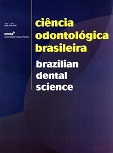Efeito do Verapamil na reparação óssea alveolar em ratos diabéticos induzidos por Aloxano: estudo histomorfométrico
DOI:
https://doi.org/10.14295/bds.2009.v12i1.251Abstract
Objetivos: Avaliamos o efeito crônico do Verapamil (agente bloqueador de canais para cálcio) sobre o processo de reparação tecidual em ratos diabéticos.Material e Métodos: Foram utilizados 36 ratos albinos Wistar, subdivididos em três grupos: Controle(C), Diabético (D); Diabético tratado com verapamil IP 10 mg/Kg peso corpóreo/dia (DVe). A indução do diabetes foi promovida pela administração de alloxano (40mg/Kg peso corpóreo) e confirmada através de análise plasmática de glicose (glucosímetro). Todos os animais foram sacrificados nos períodos de 15, 30, 45 e 60 dias após ciriurgia do incisivo central superior, e submetidos a análises histológicas e histomorfométricas. Resultados: Observamos variações significativas nos valores de formação da matriz óssea nos Grupos D e DVe em todos os períodos avaliados. Conclusões: O uso crônico do verapamil (grupo Dve) alterou significativamente a matriz óssea neoformada (p<0.01) quando comparado ao grupo Diabético. A qualidade da estrutura óssea nos grupos induzidos a condição diabética foram semelhantes. A velocidade do processo de reparação tecidual foi maior no grupo Dve comparado ao grupo D (p<0.01).Downloads
Downloads
Published
How to Cite
Issue
Section
License
Brazilian Dental Science uses the Creative Commons (CC-BY 4.0) license, thus preserving the integrity of articles in an open access environment. The journal allows the author to retain publishing rights without restrictions.
=================




























